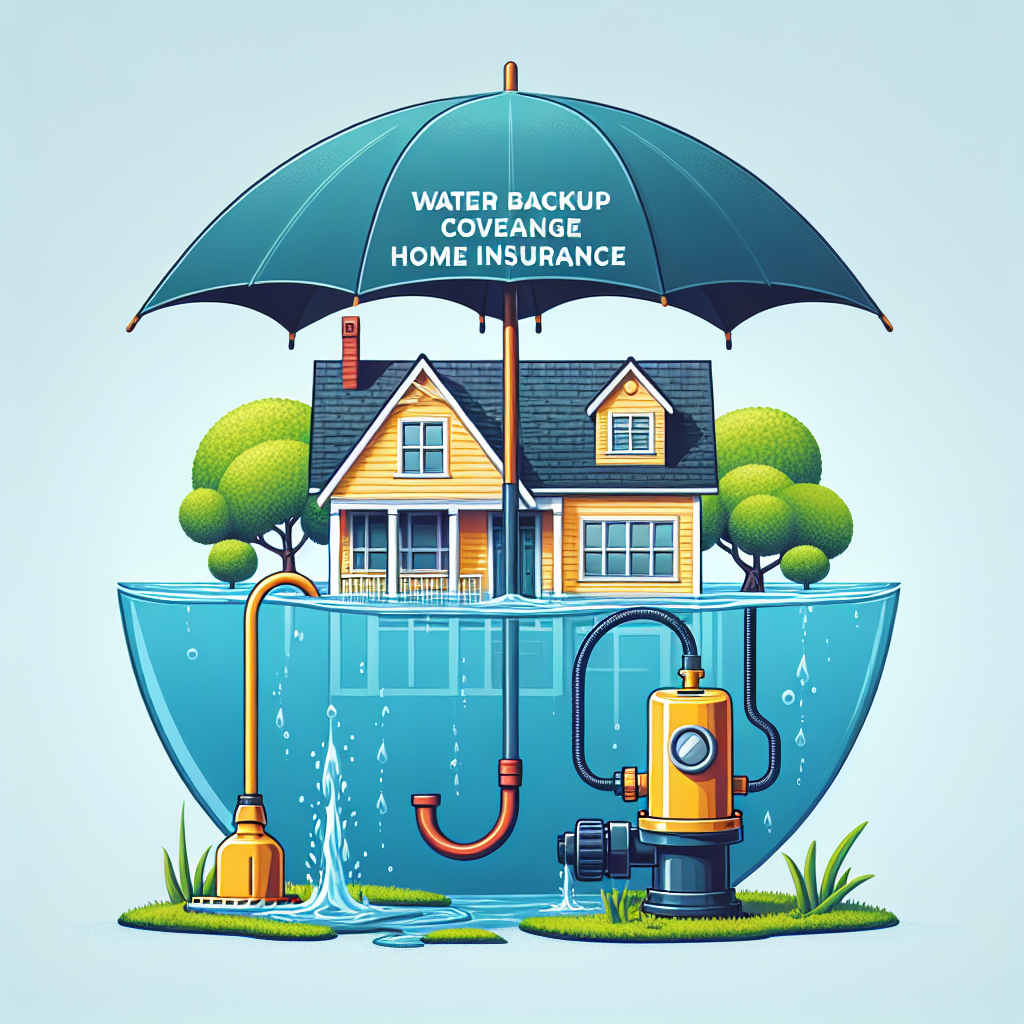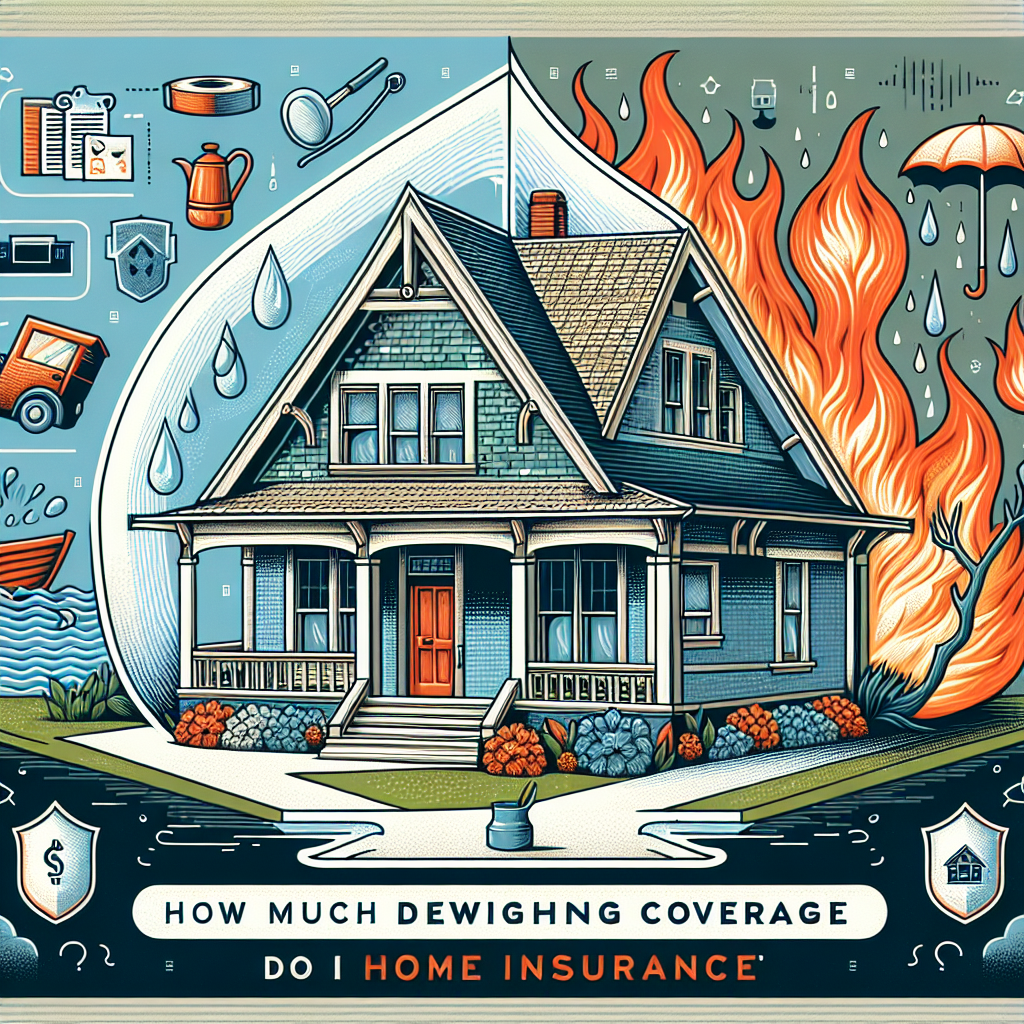Filed under Home Insurance on
Water Backup Coverage Home Insurance Guide

If your home has ever dealt with a soggy basement after a storm or a stubborn sewer line, you know that a few inches of unwanted water can lead to thousands of dollars in cleanup and repairs. Many homeowners are surprised to learn that standard home insurance usually doesn’t pay for damage caused by water that backs up through drains or overflows from a sump pump. That’s where water backup coverage enters the picture. This guide explains what it is, what it covers, what it costs, and how to choose the right amount—so you can protect your home and your budget with confidence.
What Counts as a “Water Backup” Event?
Insurers typically define water backup as water or sewage that backs up through sewers or drains, or water that overflows from a sump pump or related equipment. Common triggers include heavy rain that overwhelms municipal systems, tree roots invading old sewer lines, clogged drains, power outages that disable sump pumps, or aging pipes failing at the worst possible time.
This is not the same as flood damage. While flood insurance deals with rising water originating outside your home—such as river overflow, storm surge, or surface water—backup involves water reversing direction through your home’s drainage or sump system. That difference is crucial for coverage and claims.
What Does It Cover?
While policies vary, the goal is to help you remediate the mess and restore what’s damaged. A typical endorsement can include:
- Professional water extraction, sanitation, and drying to prevent mold growth
- Repair or replacement of damaged flooring, drywall, baseboards, doors, and built-ins
- Replacement of personal property stored in affected areas (furniture, electronics, clothing, decor)
- Cleanup of sewage contamination and disposal of unsalvageable materials
- Some policies include limited coverage for mold remediation if the mold results directly from a covered backup
- In certain cases, additional living expenses if the home is temporarily uninhabitable during remediation
Most endorsements include a sublimit—commonly $5,000, $10,000, $25,000, or more—separate from your dwelling limit, and a specific deductible that may differ from your home policy’s standard deductible. It’s smart to check both the sublimit and the deductible before a loss happens.
What’s Not Covered
Understanding exclusions prevents surprises. These are common limitations you may see across insurers:
- Flooding from outside your home (covered under separate flood insurance)
- Groundwater seeping through foundations or basement walls (often excluded as “seepage”)
- Long-term leaks or maintenance issues, including mold unrelated to a covered backup
- Damage to municipal infrastructure outside your property line
- Certain mechanical breakdowns of your sump pump (unless paired with equipment breakdown coverage)
Because the details differ by carrier, always review the endorsement language or ask your agent to break down the fine print in plain language.
Why This Risk Is Growing
Industry data and on-the-ground reports point to rising water damage losses. Urban development adds more impermeable surfaces, pushing storm runoff into aging sewer systems. More finished basements mean higher repair costs per incident. Extreme weather is introducing heavier downpours in many regions. Property adjusters and restoration companies consistently rank water-related claims among the most frequent and costly. While exact figures vary by source and year, multiple insurance associations report that water damage ranks near the top of homeowners claims both in frequency and severity, second only to events like wind and hail in many states.
How Much Does It Cost?
Premiums for the endorsement are typically modest relative to potential losses. Many homeowners pay somewhere between $40 and $250 per year depending on:
- Selected sublimit ($5,000 vs. $25,000 or higher)
- Home age, plumbing materials, and whether you have a finished basement
- Presence of a sump pump and whether it has a backup power source
- Local loss patterns and municipal infrastructure
- Overall policy underwriting factors and your claims history
Because one substantial cleanup can run into the tens of thousands—especially with finished spaces—many homeowners find the endorsement cost-effective.
Who Needs It Most?
Every home with below-grade living space can benefit, but some profiles face elevated risk:
- Homes with finished basements (carpeting, drywall, media rooms, guest suites)
- Properties with sump pumps or a history of backups or slow drains
- Older neighborhoods with clay or cast-iron sewer laterals prone to tree root intrusion
- Areas with frequent heavy rain or combined sewer-stormwater systems
- Homes on relatively flat lots or with negative grading toward the foundation
Even if you’ve never experienced a backup, a single intense storm or an unnoticed root problem can change the calculus overnight.
How Much Coverage Should You Buy?
Choosing a sublimit isn’t guesswork; estimate what a worst-case incident would cost in your home. Consider:
- Materials in the basement: carpet, engineered wood, drywall, insulation, built-ins, doors, trim
- Systems and appliances: furnace, water heater, washer/dryer, electrical panels at low levels
- Personal property: storage bins, furniture, electronics, area rugs, holiday decor
- Specialty finishes: home theaters, custom cabinetry, bars, bathroom fixtures
- Cleanup costs: water extraction, decontamination, demolition, drying equipment rental
Request sample estimates from restoration contractors or ask your insurance agent for claim scenarios in your ZIP code. If your basement is fully finished and furnished, a $5,000 sublimit is frequently inadequate. Many homeowners opt for $10,000 to $25,000, and some carriers allow higher limits. Align your deductible with what you’d be comfortable paying out of pocket.
How It Differs from Other Coverages
Sewer or Drain Backup vs. Flood Insurance
Flood insurance (often through the National Flood Insurance Program or private flood carriers) addresses rising water from outside your home. Backup endorsements handle water or sewage coming up through sewers, drains, or overflowing from a sump pump. It’s not either/or; households in risk-prone areas sometimes carry both.
Service Line Coverage
Service line coverage can pay to repair or replace underground pipes you own, like the water or sewer lateral between your house and the street. It doesn’t usually pay for indoor cleanup of a backup event, but it can address the root cause by fixing a collapsed or root-damaged line.
Equipment Breakdown Coverage
Mechanical breakdown coverage may help repair or replace failed equipment like a sump pump motor due to mechanical or electrical failure. Again, that’s different from cleaning up the water damage itself, which is where the backup endorsement applies.
How to File a Claim (and Maximize Your Payout)
Speed and documentation matter. If you experience a backup:
- Stop the flow and protect property. Shut off affected fixtures, kill power to wet areas if it’s safe to do so, and move belongings out of harm’s way.
- Call your insurer or agent. Report the claim and confirm you have the endorsement, the sublimit, and the applicable deductible.
- Document everything. Take photos and video before cleanup. Keep receipts for plumbing repairs, cleanup, drying equipment, and temporary housing if applicable.
- Hire certified professionals. Many insurers prefer IICRC-certified water mitigation firms. Quick drying can reduce both damage and disputes.
- Save damaged items until the adjuster inspects. If disposal is necessary for safety, keep photos and a detailed list.
- Get a plumber’s report. A clear description of the cause (e.g., root intrusion, municipal overload, pump failure) helps validate the claim.
- Track additional living expenses. If you must relocate during remediation, keep meticulous records.
Communicate early and often with your adjuster. If something isn’t covered, ask for the policy language reference. If an estimate seems low, provide contractor quotes or invoices that detail materials and labor.
Prevention That Insurers Love (and That Actually Works)
Risk mitigation helps prevent losses and strengthens your underwriting profile:
- Install a backwater valve to prevent sewage from flowing back into your home’s drains.
- Add a battery backup or water-powered backup to your sump pump to handle power outages.
- Grade soil away from the foundation and extend downspouts to discharge water at least 6 feet from the house.
- Clean gutters and downspouts every season and after major storms.
- Schedule periodic camera inspections of your sewer lateral, especially in older homes or heavily treed lots.
- Avoid flushing wipes, grease, or hygiene products; even “flushable” wipes can cause clogs.
- Store items in waterproof bins on raised shelving in basements.
Some insurers offer premium credits for certain upgrades like backwater valves or monitored sump pump alarms. Ask your agent which improvements qualify for discounts.
How to Compare Quotes and Policy Language
Not all endorsements are identical. When shopping, compare these features side-by-side:
- Sublimit options: $5,000, $10,000, $25,000, or higher
- Deductible: flat amount or percentage, and whether it differs from your base policy
- Covered causes of loss: sewer or drain backup, sump overflow, power outage impacts
- Personal property settlement: actual cash value vs. replacement cost
- Mold and fungus sublimits: whether remediation is included and to what extent
- Additional living expense: included or excluded for backup-related losses
- Service line and equipment breakdown add-ons: availability and pricing
Ask for the full endorsement form number and a specimen copy. A good agent or broker will point out key differences and match coverage to your home’s unique risk profile.
Expert Insights and Industry Trends
Restoration contractors emphasize the 48-hour rule: dry building materials quickly to mitigate mold and reduce repair scope. Plumbing pros increasingly recommend backwater valves in older municipalities and dual-pump sump systems for homes in high water table areas. Insurance analysts note that water damage has become a strategic loss driver; many carriers are refining policy language and pricing to balance affordability with rising claim costs. As smart-home sensors improve, more insurers are piloting discounts for water monitoring and automatic shutoff devices.
Real-World Claim Scenarios
Scenario 1: Sump Overload After a Storm
During a prolonged thunderstorm, a single sump pump runs nonstop and eventually fails. Groundwater pours into a finished basement, soaking carpet and drywall. With the endorsement in place, cleanup, drying, and repairs to finishes are covered up to the sublimit, after the deductible. The pump itself may be addressed under equipment breakdown if purchased, otherwise it’s often considered equipment wear and tear and not covered under the backup endorsement.
Scenario 2: Sewer Line Clog from Tree Roots
A mature oak’s roots intrude into a clay sewer lateral. Wastewater backs up into a basement bathroom and laundry room. The endorsement helps pay for cleanup and damaged finishes. Service line coverage could help repair or replace the damaged underground pipe—addressing the cause and reducing recurrence risk.
Scenario 3: Basement Storage Loss
Boxes of holiday decorations, a rug, and a set of speakers are destroyed by contaminated water after a municipal system overload. The endorsement contributes toward personal property losses up to the sublimit, subject to personal property settlement terms (actual cash value vs. replacement cost) and any special sublimits for certain categories.
Checklist: Prepare Your Home and Your Policy
- Review your declarations page to confirm you have the backup endorsement and the sublimit.
- Inventory basement contents and estimate replacement costs.
- Consider service line and equipment breakdown add-ons if your risk profile suggests value.
- Install a backwater valve and a sump pump with battery backup; maintain both annually.
- Store valuables in waterproof containers and raise items off the floor.
- Ask your agent about discounts for mitigation devices.
- Keep a list of emergency contractors: a licensed plumber and an IICRC-certified mitigation firm.
Frequently Asked Questions
Is this included in a standard homeowners policy?
Usually not. Most homeowners policies exclude damage from water backing up through sewers or drains or from sump overflow unless you add the endorsement. That’s precisely why many agents recommend water backup coverage as a routine add-on.
Is it the same as flood insurance?
No. Flood deals with rising water from outside your home; backup deals with water reversing through drains or overflowing from sump systems. Many households near rivers or with high water tables consider carrying both, depending on their risk.
Will it pay to replace my sump pump?
Not typically under the backup endorsement itself. It’s designed for the resulting water damage, not mechanical repair. Separate equipment breakdown coverage may help with the pump if the failure qualifies.
What limit should I pick?
Estimate a realistic worst case by tallying finishes, personal property, and cleanup costs in affected spaces. Finished basements often call for higher sublimits, like $10,000 to $25,000 or more, depending on the build-out and contents.
Will my rate go up after a claim?
It can. Insurers consider claims history when pricing renewals. That said, avoiding a claim to prevent a potential increase can be risky if out-of-pocket costs would be severe. Discuss the trade-offs with your agent.
Does a home warranty cover backups?
Home warranties sometimes help with mechanical failures of covered systems, but they don’t cover the water damage cleanup and repair that an insurance endorsement addresses. They serve different purposes.
How to Talk to Your Agent
Maximize your time and get accurate pricing with these targeted questions:
- What sublimits and deductibles are available, and which do you recommend for my home?
- Does the endorsement include sump overflow and power outage-related backups?
- How do you settle personal property—replacement cost or actual cash value?
- Is mold remediation included, and what are the sublimits and time requirements for mitigation?
- Can I bundle service line and equipment breakdown coverage, and what’s the added cost?
- Do you offer discounts for backwater valves, battery-backed sump pumps, or water sensors?
Balancing Cost, Risk, and Peace of Mind
The best insurance strategy blends prevention, the right endorsements, and a realistic view of your home’s vulnerabilities. If your basement contains anything you’d miss—family keepsakes, a home office, a guest suite, even just a washer and dryer—one backup can be more than an inconvenience. It can be a costly disruption.
That’s why many homeowners add water backup coverage alongside other practical upgrades like a backwater valve and a dual-sump system with battery backup. The endorsement is relatively inexpensive, the risk is widespread, and claims can be messy and expensive—literally and figuratively. With the right limit, you protect both your property and your savings.
Key Takeaways
- Standard home insurance generally excludes damage from sewer or drain backups and sump overflows.
- An endorsement can cover cleanup, repairs, and personal property up to a chosen sublimit.
- Costs are modest compared to the price of a single incident, especially in finished basements.
- Pair the endorsement with prevention: backwater valve, sump pump backup, proper grading, and routine maintenance.
- Clarify the fine print—sublimits, deductibles, mold coverage, and personal property settlement—to avoid surprises.
Final Word
If you only remember one thing, make it this: a small add-on can shield you from an outsized expense. Talk to your agent about water backup coverage, test your sump system before storm season, and take simple steps to keep water headed where it belongs—away from your home and your peace of mind.





